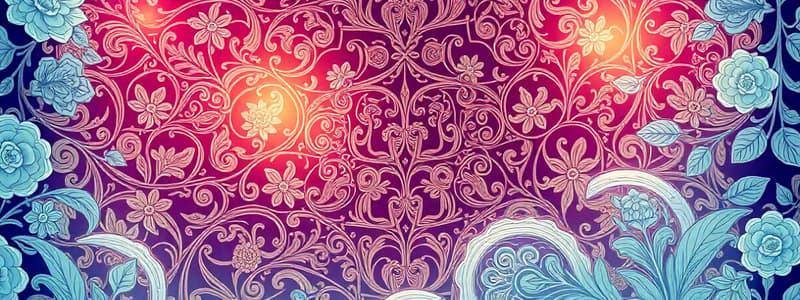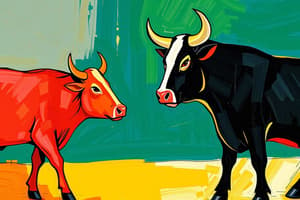Podcast
Questions and Answers
What occurs when businessmen invest in longer processes of production?
What occurs when businessmen invest in longer processes of production?
- An immediate decrease in capital goods prices
- A reduction in the length of the production structure
- A sustained increase in consumer goods production
- A shift of investment from lower to higher orders of production (correct)
What is the consequence of a genuine fall in time preferences and an increase in saving?
What is the consequence of a genuine fall in time preferences and an increase in saving?
- A shift towards consumer goods production
- The lengthened structure of production could be indefinitely sustained (correct)
- Immediate liquidation of all investments
- Decrease in wages across all industries
What happens to the demand as the new money percolates downward through the economy?
What happens to the demand as the new money percolates downward through the economy?
- Demand only increases for capital goods
- Demand shifts back to the lower orders of production (correct)
- Demand is eliminated completely
- Demand remains constant across all production levels
What is indicated by higher orders of production becoming wasteful?
What is indicated by higher orders of production becoming wasteful?
What prompts capital goods industries to find their investments in error?
What prompts capital goods industries to find their investments in error?
What leads to a boom-bust cycle in the economy?
What leads to a boom-bust cycle in the economy?
What determines the proportion of consumption to saving or investment in an economy?
What determines the proportion of consumption to saving or investment in an economy?
What effect does a lower time-preference rate have on the economy?
What effect does a lower time-preference rate have on the economy?
How does bank inflation mislead businessmen regarding saved funds for investment?
How does bank inflation mislead businessmen regarding saved funds for investment?
What does the 'natural rate' or the going 'rate of profit' reflect?
What does the 'natural rate' or the going 'rate of profit' reflect?
What happens when banks print and lend new money?
What happens when banks print and lend new money?
What is the primary component that reflects changes in purchasing power?
What is the primary component that reflects changes in purchasing power?
What is the relationship between time preferences and interest rates?
What is the relationship between time preferences and interest rates?
Flashcards are hidden until you start studying
Study Notes
Pure Interest Rate
- Determined by individuals' time preferences, reflecting how much they prefer present vs. future satisfactions.
- Lower time preference leads to lower pure interest rate, greater investment, and longer production structure.
- Higher time preference leads to higher pure interest rate, decreased investment, and shorter production structure.
Market Interest Rates
- Reflect pure interest rate plus entrepreneurial risk and purchasing power components.
- Entrepreneurial risk creates a structure of interest rates instead of a single uniform one.
- Purchasing power components reflect changes in the dollar's value and entrepreneurs' positions relative to price changes.
The "Natural Rate"
- Initial manifestation of pure interest rate.
- Also known as the "going rate of profit."
- Reflected in loan market interest rate, determined by the prevalent profit rate.
Bank Credit Expansion
- When banks inject new money into the loan market, it lowers interest rates.
- Creates an illusion of increased saved funds for investment.
- Misleads businesses into believing they have more capital for investment than is actually available.
Investment Distortions
- Increased bank-created money leads businesses to invest in "longer processes of production," particularly in higher orders of production.
- This shift is driven by artificially low interest rates and mistaken perception of increased savings.
- Investment shifts artificially from "lower" to "higher" orders of production.
Economic Imbalance
- This shift in production caused by bank credit expansion is unsustainable, as it's not based on real savings.
- Once new money reaches factors of production (wages, rents, interest), people revert to their original consumption-investment proportions.
- Demand shifts back from higher to lower orders, revealing the malinvestment in higher orders of production.
Capital Waste
- The malinvestment in higher orders of production is liquidated, reflecting an excess of capital in those sectors.
- Bank credit creation leads to a boom-bust cycle, where artificially low interest rates distort investment patterns, leading to wasted economic resources.
Studying That Suits You
Use AI to generate personalized quizzes and flashcards to suit your learning preferences.




